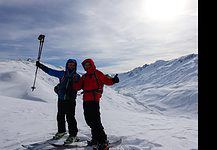Travel to Sri Lanka
Sri Lanka is an island country of South Asia, found in the Indian Ocean, just off the southern tip of India. Newly emerging as an attractive tourism spot after years of civil strife, Sri Lanka has plenty of culture and history.
The Aryans arrived in Sri Lanka, from India in the 6th century BC and integrated with the locals to establish the Sinhalese ethnic group. Buddhism came to Sri Lanka in the 3rd century BC and great civilizations were established at Anuradhapura and Polonnaruwa – both UNESCO World Heritage sites.
The Dambulla Cave Temple has stunning murals and over 150 Buddha statues in this well preserved cave.
The entire country was much later ceded to the British in 1815. The tea estates of 19th century hill station Nuwara Eliya and the lush greenery will transport you to the English countryside. Don’t miss the views from the Ella Gap.
Adam’s Peak is a biodiversity spot and a UNESCO World Heritage Site. The Sri Pada, considered as the footprints of Buddha along with the unsurpassed views are points of interest.
The Old Dutch Fort at Galle has a wonderful charm with its sea views. The beaches of Arugam Bay provides water sport activities along with lovely Sri Lanka beach resorts.
Sigiriya Rock Fortress is probably the most stunning image of Sri Lanka.
We hope you find our detailed guide to Sri Lanka useful in planning future Sri Lanka holidays.
Travel tips for Sri Lanka
Visa Requirements for Malaysia
Citizens of a few countries must obtain a Sri Lankan Visa from the Sri Lankan consulate or embassy in the place they reside in, before they start planning their Sri Lanka itinerary.
Nationals of Maldives, Singapore and Seychelles may obtain a free Sri Lanka visa on arrival.
Residents of all other countries must complete an electronic travel authorization (ETA), preferably prior to arrival, as sometimes it may be rejected. The ETA permits dual entry to the visitor for a period of 30 days. Only if the ETA has been approved, can one obtain a visa on arrival.
Please check the current guidelines in advance, of the visa requirements for your country and start processing your online Sri Lanka visa.
Important Cultural Information
The two official languages of Sri Lanka are Sinhala (spoken by the Sinhalese majority) and Tamil (spoken by the Tamil and Muslim minorities).
The Sri Lanka climate is tropical and has distinctive dry and wet monsoon seasons.
In the larger cities and beach and tourist areas you will find a number of people able to converse in English. However, this is not to be expected in the rural areas.
The traditional greeting in Sinhala is Ayubowan or “May You Live Longer”. It’s useful to know a few other terms like Bohoma sthuthi (“Thank you”) and Kohomada (“How are you?”). To greet someone in Tamil, say “Vanakkam”.
The Sri Lankan people eat with their right hands and more specifically with the tips of their fingers. If you are unable to do this, wielding your cutlery with the right hand is also acceptable. Use your right hand when handling money, handing over something or shaking hands.
Remember to remove shoes and dress conservatively when visiting temples (no shorts, mini skirts or tank tops). Never turn your back to a statue of Buddha or pat the heads of Buddhist monks.
Public displays of affection are not appreciated. Public nudity is illegal in Sri Lanka.
Banking & Money in Sri Lanka
The currency of Sri Lanka is the Sri Lankan rupee (LKR). Coin denominations are 25 and 50 cents (bronze), 1 rupee (gold), 2 rupees (silver) and 5 rupees (gold). A range of bank notes are available from LKR 10-5000.
The names of some banks operating in Sri Lanka include Amana Bank PLC, Bank of Ceylon, Commercial Bank of Ceylon PLC, Hatton National Bank PLC, Union Bank of Colombo PLC and some more widely known names like Citibank N.A., Deutsche Bank AG, ICICI Bank Ltd and Standard Chartered Bank.
There are many ATMs across Sri Lanka. However, not all banks accept international debit and credit cards. Hatton National Bank, Commercial Bank, Sampath Bank, Bank of Ceylon, among others – have ATMs that accept international cards.
ATM machines take the card into the machine and three unsuccessful PIN attempts result in the machine keeping the card. Cards can be retrieved with proper identification and a machine receipt within 3 days and during working hours.
Any leftover Sri Lankan currency can be exchanged at the airport on departure, provided you carry the original money receipt for acquiring the funds.
Medical Emergency Information
During a police emergency use hotline numbers 119 or 118.
The Ambulance or Fire and Rescue number is 110.
The Tourist Police Number is 011-2421052.
Accident service at Colombo General Hospital is 011-2691111.
Recommended vaccinations for visitors to Sri Lanka include those for Typhoid, Hepatitis A and B, tetanus and Japanese encephalitis. Dengue fever is a concern during the rainy season and prophylaxis is required in absence of a dengue vaccine.
The National Hospital of Sri Lanka, Colombo is a well known Sentra government hospital. The names of some private hospitals in Colombo include Durdans Hospital, Lanka Hospitals, Western Hospital and Nawaloka Hospital.
If you’re looking for travel insurance, we are an affiliate of World Nomads.
Wi-Fi and Internet in Sri Lanka
The country code for Sri Lanka is 94.
There are 4 major cell phone operators: Dialog, Mobitel, Etisalat and Airtel.
GSM/3G/HSPA/4G LTE cell phones are in use and the network coverage is good.
Dialog Mobile has the best network coverage, spreading even to rural areas.
You can collect a free SIM card at the immigration counters of Bandaranaika International Airport. If you have an unlocked phone, accessing the internet should be a breeze. To surf the internet, access the 4G LTE networks of Dialog Mobile or buy an HSPA dongle and a Mobile Broadband connection.
You should be able to access Wi-Fi in hotels and dorms and at popular eateries around town. Make sure to use a VPN while traveling and using public Wi-Fi (we recommend ExpressVPN).
Arrival in Sri Lanka
The main point of entry by air into Sri Lanka is through Colombo-Bandaranaika International Airport (CMB). The main flagship airlines of Sri Lanka is SriLankan Airlines, which operates between Southeast Asia, Australia, China, Japan, India, the Middle East, Pakistan and Sri Lanka.
KLM connects Amsterdam to Colombo. Emirates has daily flights from Dubai to Colombo. Etihad connects Abu Dhabi and Colombo, while Qatar Airways connects Doha and Colombo. Other airlines offering flights to Colombo include Singapore Airlines, Turkish Airlines, Oman Air, Malaysia Airlines and Cathay Pacific. To travel to Sri Lanka from the USA or Canada you must first transit through one of the previously mentioned travel hubs in Europe, the Middle East or Asia and then arrive in Sri Lanka.
Search for flights to Sri Lanka on Expedia.
Areas of Sri Lanka
Sri Lanka is a country with several provincial regions. The main cities are the administrative capital Sri Jayewardenepura Kotte, the commercial capital of Colombo, Kandy and the ancient city of Galle.
Central Province
The central province, located in the heart of the island contains the city of Kandy, considered by many to be the country’s cultural capital and on the UNESCO World Heritage site list. The region consists of tea plantations, lush vegetation, waterfalls and streams. World’s End, in Nuwaraeliya is found in the Central Province.
Northern Province
The Northern Province, for the longest time was under the grips of Civil War but now is relatively peaceful, although there are places that still contain landmines. Separated by a short stretch of water, the Palk Strait, from the Indian mainland, this area is slowly reviving its reputation as a tourist attraction.
North Central Province
The North Central Province consists of the renowned cultural triangle with over 2500 years of ancient history. The cultural triangle consists of Anuradhapura, Polonnaruwa and Kandy. This region lays claim to 5 world heritage sites in Sri Lanka. They are the ancient city of Polonnaruwa, the ancient city of Sigiriya, the sacred city of Anuradhapura, the sacred city of Kandy and the Central Highlands of Sri Lanka.
Eastern Province
The Eastern Province skirts the Bay of Bengal and has many beach resorts including Arugam Bay.
North Western Province
The North Western Province on the Gulf of Mannar is teeming with biodiversity, particularly Wilpattu National Park.
Sabaragamuwa
A landlocked province, home to Adam’s Peak and myriad waterfalls.
Southern Province
The Southern Province contains the ancient city of Galle.
Uva
Uva, another landlocked province has many highlands. A hilly destination with many tea estates.
Western Province
The Western Province is home to the capital – Sri Jayewardenepura Kotte and also Colombo.
Transportation in Sri Lanka
The most common mode of transport within Sri Lanka is the three wheeler tuk-tuk taxi. They come in various sizes with larger ones able to transport luggage as well. They are open on all sides and lack seat belts, so riding these is not for the faint hearted.
Driving in Sri Lanka is possible by renting cars, either with a driver or for self-drive. Cars can be hired from most hotel reception desks in Colombo. To self drive a car in Colombo you must have an international driver’s license that is validated from a Sri Lanka licensing center. Malkey, Kings Rent a Car or Casons are places to rent cars from. Driving is left sided and can be quite chaotic, so beware.
Taxis are a good way to get around Colombo and when the meter is used, may work out cheaper than a tuk-tuk. Budget-taxis that are metered are a popular option too. Pickme is a taxi service app with which you can hire tuk-tuks and mini cars.
You can find AC and non-AC buses that operate in various areas and routes. Sri Lanka has an extensive rail network system with three different classes. Observation cars are available for the more picturesque routes.
Cinnamon Air flies small seaplanes for photography trips over Nuwara Eliya, Kandy, Galle and other places. Helitours runs domestic flights between Colombo City Airport and Jaffna, Trincomalee and Ratmalana.
Accommodation in Sri Lanka
The hospitality industry in Sri Lanka has slowly tailored itself for the emerging need to create places to stay for the international traveler. Traditional beach hotels built in the 1960s have made way for villas, boutique hotels and Sri Lanka resorts.
If looking for backpacker hostels and budget accommodations you can find many with prices starting as low as 5 dollars per night for dorm style accommodation. Colombo’s Fort YMCA is a good option. Backpacker hostels are not as ubiquitous around Sri Lanka as other budget options like ‘guesthouses’. Most guesthouses are homes that have been converted and are often clean and comfortable.
Aside from budget accommodation options, high-end brand names like the Hyatt, Shangri-La, Avani, Hilton have properties in all major cities in Sri Lanka. Homegrown brands like Jetwing Hotels, Resplendent Ceylon and Cinnamon Hotels and Resorts are also to be found.
What to eat and drink in Sri Lanka
The staple food of the Sri Lankan people is rice and curry. Sri Lankan cuisine is quite spicy but you can request for the food to be spiced down to your preference. Casual eateries by the roadside, called ‘hotels’ will serve you rice and curry. The food is simple and cheap and the rice portions are very generous. You can also ask for spicy rolls called ‘short eats’.
Some specialty Sri Lankan dishes to try include :
- Kottu Roti (veggies, chopped roti and meat)
- Polos (green/raw jackfruit curry)
- Hoppers (small fermented rice flour cakes made with coconut milk)
- String Hoppers (made from thicker dough than hoppers and pressed into noodles)
- Kukul mas curry (Chicken curry)
Kiribath (rice with coconut milk) and Lunu Miris (chilli paste made from dried fish, red chilli, onion, lemon juice and salt)
Pernakan/Nonya cuisine is a mix of Malay and Chinese cooking. Chilli Crab and Laksa lemak (noodles in coconut broth with cockles or shrimp) are special dishes to try.
Food and Drinks in Sri Lanka
Things to do and see in Sri Lanka
Here are some of the best places to visit in Sri Lanka.
For beach lovers visit Unawatuna, Galle, Trincomalee and Pasikuda’s beautiful Sri Lanka beaches. These are amongst some of the best beaches in Sri Lanka. Mirissa and Kalpitiya provide whale and dolphin watching tours.
Nuwara Eliya has lovely green villages that will fool you into thinking you are in the English countryside. Numerous tea estates and Hakgala Botanical Gardens add to the rural charm of this area. Here’s a few more places to visit in Nuwara Eliya beyond the tea plantations.
Anuradhapura and Polonnaruwa are places to visit ancient temple ruins.
When visiting Kandy, don’t miss visiting the Sri Dhalada Maligawa and Peradeniya Botanical Gardens. If you are interested in witnessing some traditional dance forms, the city hall hosts a Sri Lanka dance performance every evening at 5. Here’s how to spend 2 days in Kandy.
For visitors who enjoy the outdoors, there are no dearth of views in Sri Lanka. In Matale, climb the Sigiriya or Pidurangala Rock. Enjoy the ancient frescoes and the panoramic vistas. Climbing Riverstone to see the Mini Worlds’ End.
For Sri Lanka wildlife spotting, head to one of the Parks, like Yala National Park, Wilpattu or Wasgamuwa for a Sri Lanka safari.
To sum up our Sri Lanka attractions, in Colombo there’s plenty to see including the Dehiwala Zoo, Galle Face Terrace, Independence Square Arcade or the Floating Market at Bastian Mawatha. There’s also a few fun things to do in the neighborhood of Kollupitiya in Colombo.
Travel tips for Sri Lanka
Shopping in Sri Lanka
A trip to Sri Lanka should leave time for souvenir shopping because Sri Lanka has markets filled with lovely handicrafts, jewelry, textiles and much more.
Make sure to pay attention to crafted jewelry and batik items. The cities to head to for shopping are Colombo and Kandy where you can shop for both street market goods and high-end products in plush malls.
Regarding cloth items do keep your eyes out for traditional sarees, sarongs, fabric bags, kurtas and more. The textiles will often be crafted out of hand loom fabrics and batiks. Wall hangings, home decor and prints are also popular gifts too.
Arcade Independence Square in Colombo for high end fashion, Ratnapura for gemstones, Laksala in Colombo for budget friendly souvenir shopping and Paradise Road, Colombo for special gifts – are the places to visit. If you are looking for shopping malls visit Majestic City in Colombo.
Nightlife
Some of the best towns to experience Sri Lanka’s nightlife are Colombo, Kandy and Galle.
Colombo is a tourist friendly place with many stylish bars and pubs and one of the best places to party well into the night. Head to the Zaza Bar for exotic drinks or the Barefoot Garden Cafe for wine, drinks and delicious pork curry and spinach quiche. Nighttime gigs wind well into the night.
Kandy, the second largest city is less busy, has less traffic and is relatively quiet. Nevertheless head to a few places for the food and drink. Le Garage, with a garage themed nightclub and Old Trinitians Sports Club are spots to checkout.
The coastal town of Galle has some good surf lounges (Koha Surf Lounge) and beach bars (Yula Beach Bar).
Safety Tips for Sri Lanka
Tattoos of religious figures, like Buddha and images on items like t-shirts are considered disrespectful and in some cases illegal. Homosexuality is also illegal in Sri Lanka. Solo female travel is not recommended in Sri Lanka. Exercise caution around the Galle Face Road area for crooks who try to wheedle money out of you.
Keep your eyes open for a few common scams. Some of them involve tuk-tuk and taxi drivers. They may not provide you with exact change or may overcharge you for the entire trip cost instead of splitting it up between passengers. The Spice Garden scam involves offering you a free ride to a Spice Garden in the middle of nowhere and making you buy expensive, adulterated products if you wish to return to civilization. Numerous other scams like gem and jewelry shop scams also exist, so please learn about these before traveling to Sri Lanka.
Sri Lanka has a recent history of civil war and strife, which ended in 2009 when the government wiped out the LTTE. However, many undiscovered landmines still exist in remote areas that are still being cleared. Unfortunately terrorism and terror attacks are still part of the national landscape of Sri Lanka.
Conclusion
Known as the ‘The Teardrop of India”, Sri Lanka is emerging as one of the most exciting tourist destinations in South Asia.
Renewed global interest in visiting Sri Lanka, after the ravages of the Civil War, has resulted in the revival of the hospitality industry in Sri Lanka. Traditional beach hotels have made way for plush villas, boutique hotels and splendid resorts.
Sri Lanka offers to the curious traveler, a wealth of history, culture, charm, spellbinding views, warm weather and delicious cuisine.
As a tourist destination there is something for everyone. For beach lovers there are spectacular beaches at Arugam Bay with a wealth of water sport opportunities.
Colombo and Kandy are the larger cities with lots of opportunities to experience the nightlife, local cuisine and culture. Shopping malls and small markets abound.
If you want to delve deeper into the ancient history of Sri Lanka visit the ancient cities of Anuradhapura and Polonnaruwa for the temple relics- both UNESCO World Heritage Sites.
We hope that mentioning these places has made you curious to visit the sublime island country of Sri Lanka- known as the ‘Pearl of the Indian Ocean’.




























